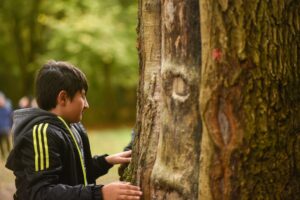How to promote Outdoor Learning in school
A recent poll widely shared in the news reveals that 43% of children aren’t looking forward to days spent “cooped up in their classrooms.” As you prepare for students returning to school, could this be the perfect opportunity to consider how you use outdoor learning to deliver your curriculum?
Pupils and teachers notice improvements in concentration and behaviour, and benefits to mental health and wellbeing when outdoor learning is incorporated in lessons. COVID-19 has given us an opportunity to embrace this as a solution for classrooms needing to socially distance students.
So how can you embed outdoor learning into your school curriculum and ethos? We look at simple ideas that are easy to implement and don’t require a huge budget to achieve.
Dress for the weather
It’s easy to teach children that time outdoors is reserved for ‘perfect days’ when the sun is shining. In the UK, waiting for sunny days significantly reduces the time children can go outside. Instead, plan for students to learn outdoors whatever the weather.
Remember Maslow’s Hierarchy of Needs? At the bottom of the pyramid are those physiological essentials we need before learning can happen. Ensuring students have appropriate clothing means they won’t be distracted by feeling too hot or cold.
Clothing essentials:
- Wellies or sturdy walking boots
- Waterproof coat or all-in-one
- A spare pair of warm socks
- In the summer term: sun hat and sun cream
- In the Autumn term: woolly hat, gloves and scarf
Outdoor clothing takes up a lot of space so think about how to store it. Could you make welly racks outside the classroom doors or put waterproofs in stackable storage boxes? Consider your routines for when the children come in wet or cold to avoid tracking in mud, piles of wet clothing and disruption to learning.
Look at your curriculum
The poll mentioned earlier showed that parents want to see their children enjoying nature. 67% said they wanted schools to have at least one outdoor lesson each day. If you want to embed outdoor learning in your curriculum, this means looking at your lesson plans to make adjustments.
Think about how outdoor learning can deliver your learning objectives:
- Use nature as an inspiration or starting point for a lesson
- Complete the lesson outside rather than in the classroom
- Use natural materials to deliver the learning
You don’t have to do everything yourself. There are tonnes of ideas available online. Check out the RSPB’s free Wild Challenge which offers bronze, silver and gold awards as you complete their activities.
Or bring in experts to raise the profile of outdoor learning in your school. Wildchild offers an exciting Bushcraft Adventure day that teaches students outdoor survival skills with adventurous games and activities. It’s a real hit with the students and staff alike.
Make the outdoors part of your routine
Many school pick days each week dedicated to outdoor learning and give them a name like “Muddy Mondays” or “Welly Wednesdays.” This is a simple way to ensure that outdoor learning will happen regularly throughout your school.
Move away from the idea that being in nature is predominantly for Early Years classrooms or certain subjects like PE. Taking learning outside is suitable for every age group and you can embed it across the curriculum.
Promote outdoor learning to parents
Almost 60% of parents in the poll said their children “have taken more interest in nature” since the start of lockdown. Many say time outdoors in the environment has been a highlight for them. Let’s keep this enthus iasm going and involve parents too.
iasm going and involve parents too.
Take regular photos of outdoor learning to share on your school’s social media accounts. Parents can share photos of their children enjoying outdoor spaces at home. Just remember to check your school’s policies carefully to follow safeguarding measures.
Create special days for national wild events the whole school can celebrate. There are lots of weeks dedicated to counting nature including birds, insects, wildflowers and trees. Add them to your school calendar and make it an annual event. It’s easy to design entire units of work around them.
Find experts inside your school
It’s amazing how much talent you’ll find within your families. Send a survey and ask parents and grandparents if they have any expertise they’d like to share. It’s likely you’ll find at least a few keen gardeners in your school community.
When you can, invite these volunteers into school to hold talks and help run clubs. If you’re closed to visitors because of social distancing measures, record video interviews or ask them to write letters instead.
Use outdoor learning for homework and home learning
Don’t let outdoor learning stop at the school gates. Promote it to parents with homework and home learning they can complete outdoors. Children will love working in their garden, local park or woodland areas.
Do your students get to choose homework tasks? It’s a marvellous way to include an outdoor learning opportunity. If you want to promote learning in nature, create an award scheme with a certificate or sticker to present each week in assembly.
Create a shelter
It’s easy to stay outside for longer with some shelter available. If you have a small budget, consider spending it on a pop-up gazebo that can be quickly erected each day. Don’t worry if money is tight, just hanging a large sheet can give shade from the sun or a little rain protection.
If outdoor learning is a school priority, ask your Parent Teacher Association if this could be a fundraising project to save up for a year round covered area or outdoor classroom.
Start a gardening club
It’s difficult to squeeze gardening into the curriculum. After-school clubs offer a chance to get essential jobs done. Even if you have limited outdoor space, you can make a garden using pots and planters dotted around the school site.
Ask parents and local businesses for donations of seeds and equipment to get your garden started. Parent volunteers could help dig out allotment patches and prepare the soil. Why not have your school garden sponsored by a local company to give you a small budget to spend?
Invite your local allotment association to speak at school or record a video message to share gardening tips. You could include news from your school garden in newsletters and promote it on your social media feeds. Team up with your kitchen staff and use the products from the garden in school lunches to promote healthy eating.
Making outdoor learning work in your school
Children and parents are seeing the benefits of being in nature during lockdown. It’s far more than just playing outside. Outdoor lessons offer opportunities for the same learning to happen with all the benefits that nature brings to mental and physical health.
For outdoor learning to be a success, you can’t just bolt it on to your existing lessons. Use nature as a way to deliver your existing curriculum rather than creating more work to do. Making it an integral part of the school day is the only way for outdoor learning to be a genuine success.
If you would like Wildchild to help your school plan a special day to promote outdoor learning, we’d love to help. Our Bushcraft Adventure days can be delivered at one of our two beautiful woodland locations or we can even come to your school grounds. Get in touch to find out more.
Recent Posts
- Why you should be insisting on LOtC for your school residential trips
- The impact of Nature deficit disorder and the preventative role schools can play
- Residential trips for secondary schools to ease transition
- Building character through primary school trips
- Six reasons why more schools are choosing UK school trips (spoiler alert: it’s not because of Covid!)
- School trips after the pandemic
- 5 winter outdoor learning activities for schools
- 5 ways to get more from your School Bushcraft Trip
- Residential trips to benefit learning
- Perfect Primary School Trip Planning
Blog home






